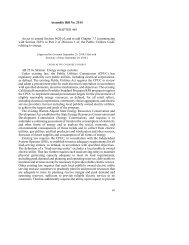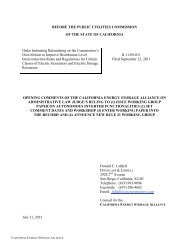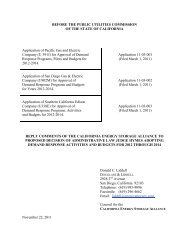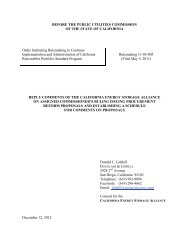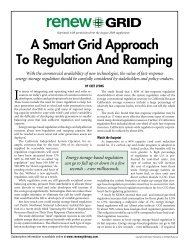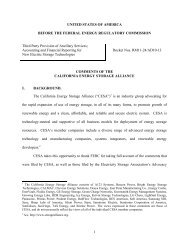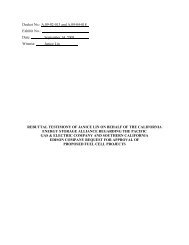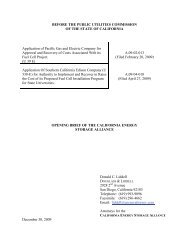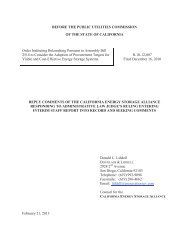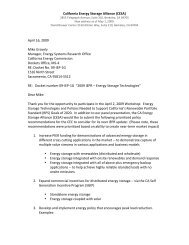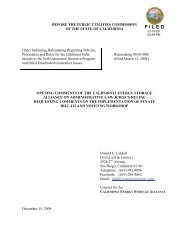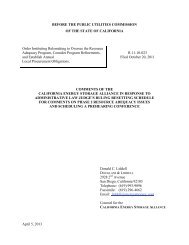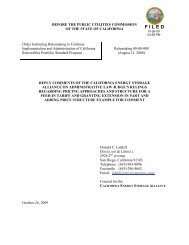Smart Grid Policies Comments - California Energy Storage Alliance
Smart Grid Policies Comments - California Energy Storage Alliance
Smart Grid Policies Comments - California Energy Storage Alliance
You also want an ePaper? Increase the reach of your titles
YUMPU automatically turns print PDFs into web optimized ePapers that Google loves.
BEFORE THE PUBLIC UTILITIES COMMISSION<br />
OF THE STATE OF CALIFORNIA<br />
F I L E D<br />
03-09-10<br />
04:59 PM<br />
Order Instituting Rulemaking to Consider <strong>Smart</strong><br />
<strong>Grid</strong> Technologies Pursuant to Federal Legislation<br />
and on the Commission’s own Motion to Actively<br />
Guide Policy in <strong>California</strong>’s Development of a<br />
<strong>Smart</strong> <strong>Grid</strong> System.<br />
R.08-12-009<br />
Filed December 18, 2008<br />
COMMENTS OF THE CALIFORNIA ENERGY STORAGE ALLIANCE<br />
ON PROPOSED POLICIES AND FINDINGS PERTAINING TO<br />
THE SMART GRID<br />
Donald C. Liddell<br />
DOUGLASS & LIDDELL<br />
2928 2 nd Avenue<br />
San Diego, <strong>California</strong> 92103<br />
Telephone: (619) 993-9096<br />
Facsimile: (619) 296-4662<br />
Email: liddell@energyattorney.com<br />
Counsel for the<br />
CALIFORNIA ENERGY STORAGE ALLIANCE<br />
March 9, 2010
BEFORE THE PUBLIC UTILITIES COMMISSION<br />
OF THE STATE OF CALIFORNIA<br />
Order Instituting Rulemaking to Consider <strong>Smart</strong> <strong>Grid</strong><br />
Technologies Pursuant to Federal Legislation and on the<br />
Commission’s own Motion to Actively Guide Policy in<br />
<strong>California</strong>’s Development of a <strong>Smart</strong> <strong>Grid</strong> System.<br />
R.08-12-009<br />
Filed December 18, 2008<br />
COMMENTS OF THE CALIFORNIA ENERGY STORAGE ALLIANCE<br />
ON POLICIES AND FINDINGS PERTAINING TO<br />
THE SMART GRID<br />
Pursuant to Ordering Paragraph Number 3 of the Assigned Commissioner and<br />
Administrative Law Judge’s Joint Ruling Amending Scoping Memo and Inviting <strong>Comments</strong> on<br />
Proposed <strong>Policies</strong> and Findings Pertaining to the <strong>Smart</strong> <strong>Grid</strong>, issued February 8, 2010 (“OIR”),<br />
and 6.2 of the <strong>California</strong> Public Utilities Commission (“Commission”) Rules of Practice and<br />
Procedure, the <strong>California</strong> <strong>Energy</strong> <strong>Storage</strong> <strong>Alliance</strong> (“CESA”) 1 hereby submits these comments.<br />
I. INTRODUCTION.<br />
First and foremost CESA takes this opportunity to relate SB 17 directly to the need for a<br />
new Commission proceeding devoted entirely to energy storage. 2 In these comments, CESA<br />
also addresses the first and third broad areas identified by the Commission as within the<br />
amended scope of this proceeding. The second area, pertaining to rules to provide customers and<br />
third parties with access to usage and price data consistent with the <strong>Energy</strong> Independence and<br />
Security Act of 2007 is very important; and CESA is confident that it will be capably addressed<br />
by others. CESA’s essential interests in this proceeding are encompassed within the first and<br />
1 The <strong>California</strong> <strong>Energy</strong> <strong>Storage</strong> <strong>Alliance</strong> consists of A123 Systems, Altairnano, Beacon Power, Chevron <strong>Energy</strong><br />
Solutions, Debenham <strong>Energy</strong>, Deeya, <strong>Energy</strong>, Enersys, Enervault, Fluidic <strong>Energy</strong>, Ice <strong>Energy</strong>, Powergetis, Prudent<br />
<strong>Energy</strong>, PVT Solar, Suntech, Xtreme Power and ZBB <strong>Energy</strong> Corporation. The views expressed in these Opening<br />
<strong>Comments</strong> are those of CESA, and do not necessarily reflect the views of all of the individual CESA member<br />
companies.<br />
2 Implicit in this policy statement, of course, is that there is no reason for the Commission to eliminate any storage<br />
options for consideration, in <strong>Smart</strong> <strong>Grid</strong> proposal or otherwise, as could be inferred from the Commission’s question<br />
posed at Section 5.4 of the Amended Scoping Memo regarding the best place for consideration of storage options,<br />
(p. 29).
third broad areas enumerated by the Commission, namely: (a) the policy matters assigned to the<br />
Commission by passage of SB 17, including providing guidance to the electric utilities so that<br />
they may develop deployment plans by July 1, 2010, and (b) development of policies to prepare<br />
<strong>California</strong>’s electric infrastructure for the growing challenges posed by greater reliance on<br />
demand reduction, load management, renewable resources and electric vehicles, facilitating the<br />
advancement of the policy goals that initiated this proceeding.<br />
II.<br />
THE COMMISSION SHOULD OPEN A NEW PROCEEDING TO ADDRESS<br />
ISSUES SPECIFIC TO ENERGY STORAGE IN A COMPREHENSIVE WAY IN<br />
ADDITION TO INCLUDING ENERGY STORAGE IN SMART GRID<br />
DEPLOYMENT PLANS.<br />
CESA’s primary goal as a party in this proceeding is to strongly advocate that energy<br />
storage be a central part of Commission’s policy as a discrete topic. 3 One of its consistent<br />
objectives is to assure that the broad policy implications of energy storage do not become “lost in<br />
the shuffle” as the Commission addresses national-level issues as in itself, energy storage does<br />
address many of these national-level issues. 4 A new Commission proceeding focused on energy<br />
storage is needed, recognizing that it is sui generis, as was done with the Commission’s recently<br />
initiated Alternative-fueled Vehicle Rulemaking. 5 As discussed below, in addition to the<br />
Commission, the Federal <strong>Energy</strong> Regulatory Commission (“FERC”), the <strong>California</strong> Independent<br />
System Operator (“CAISO”), the <strong>California</strong> Legislature, the <strong>California</strong> Attorney General, the<br />
U.S. Congress and the Obama Administration are all pushing hard to promote greater use of<br />
energy storage. 6<br />
At the CAISO, today, energy storage technology is categorized as a subset of the<br />
CAISO’s Integration of Renewable Resources Program (“IRRP”), but it is also the subject of<br />
numerous other CAISO program that deal with wholesale energy markets, including:<br />
3 CESA has also made this point in its Opening <strong>Comments</strong> on Direct Participation of Retail Demand Response in<br />
CAISO Electric Markets, filed December 4, 2009, in R.07-01-041.<br />
4 A prominent example is the <strong>California</strong> Independent System Operator’s (“CAISO’s”) efforts to comply with the<br />
Federal <strong>Energy</strong> Regulatory Commission’s (“FERC’s”) Order Numbers 890 and 719.<br />
5 Order Instituting Rulemaking to consider Alternative Fueled Vehicle Tariffs, Infrastructure, and policies to<br />
Support <strong>California</strong>’s Greenhouse Gas Emissions Reduction Goals, R.09-08-009, issued August 20, 2009.<br />
6 The <strong>California</strong> <strong>Energy</strong> Commission (“CEC”) also has very broad statutory authority to adopt load management<br />
standards to advance the use of energy storage under Public Resources Code §25403.5, See, e.g., CEC Draft <strong>Energy</strong><br />
Efficiency Committee Report, November 2008, at p. 8., and see Load Management Informational and Rulemaking<br />
Proceeding, Docket #-08-DR-1.<br />
2
o Achieving 33%<br />
o 2020 Transmission Planning Process (“RETPP”)<br />
o Non Generator Resources Participation in Ancillary Services Markets<br />
o Limited <strong>Energy</strong> <strong>Storage</strong> Resource (“LESR”) Program<br />
o Proxy Demand Resource (“PDR”)<br />
Meanwhile, energy storage is being addressed simultaneously in a plethora of<br />
Commission proceedings, which relate to the CAISO stakeholder initiative processes. For<br />
example:<br />
o Demand Response Rulemaking (R.07-01-041)<br />
• Permanent Load Shifting<br />
• Direct participation of retail load in ancillary services markets<br />
o Distributed Generation Rulemaking (R.08-03-008)<br />
o <strong>Smart</strong> <strong>Grid</strong> Rulemaking (R.08-12-009)<br />
o Resource Adequacy (R.09-10-032)<br />
o Alternative-Fueled Vehicles (R.09-08-009)<br />
o Renewable Portfolio Standard (R.08-08-009)<br />
o Long Term Procurement Plans (R.08-02-007)<br />
The Commission’s involvement in energy storage policy issues at the CAISO could be much<br />
more transparent and thus more effective. 7<br />
CESA believes that this is the appropriate time and place to take a holistic view of energy<br />
storage and define Commission-directed <strong>Smart</strong> <strong>Grid</strong> Deployments plans that will both<br />
complement the interests of the CAISO’s stakeholders, and come to grips with state-level issues<br />
and opportunities outside of the ambit of the CAISO’s and the FERC’s jurisdiction. 8 The<br />
CAISO’s Stakeholder Initiative process and the multiple related CPUC proceedings demonstrate<br />
that it is presently impossible to identify one place at the Commission to deal with the broad<br />
7 An exception may prove to be the interaction between the Commission’s demand response proceeding (R.07-01-<br />
041), and the CAISO Participating Load Pilot Project undertaken as part of its compliance with the FERC’s Order<br />
890, and Order 719. See, CAISO 2009 Report on Participating Load Pilot Project, February 18, 2010, p. 5.<br />
8 The FERC very recently issued an order on Petition for Declaratory Order stating that: “We note that electricity<br />
storage devices. . . do not readily fit into only one of the traditional asset functions of generation, transmission or<br />
distribution. Under certain circumstances, storage devices can resemble any of these functions or even load. For<br />
this reason, the Commission has addressed the classification of energy storage devices on a case-by-case basis.<br />
Western <strong>Grid</strong> Development, LLC 130 FERC 61,056, issued January 21, 2010.<br />
3
ange of policy and technical issues that relate to energy storage, and at times even difficult to<br />
navigate among the various proceedings in an efficient manner.<br />
CESA believes it is critically important to draw clear lines of demarcation as to federal<br />
wholesale and state retail regulatory jurisdiction as a necessary, but not sufficient, part of a<br />
holistic market-based approach to take full advantage of all of the benefits energy storage offers,<br />
in its many forms. The subject of energy storage in <strong>California</strong> is clearly much broader than<br />
FERC-jurisdictional transactions. Indeed, it also extends well beyond into unregulated markets<br />
that are beyond the Commission’s jurisdiction as well such as off-grid energy storage used for<br />
emergency backup and remote loads, or energy storage used solely for transportation purposes.<br />
The <strong>California</strong> Legislature is also beginning to weigh in on energy storage with AB 2514<br />
(Skinner), introduced on February 19, 2010, which would create a state-wide “<strong>Energy</strong> <strong>Storage</strong><br />
Portfolio Standard” to supplement the existing Renewables Portfolio Standard and help<br />
<strong>California</strong> achieve its renewable energy, peak load reduction and greenhouse gas emission<br />
reduction goals. The Commission is, of course, presently moving forward with implementation<br />
of SB 412 (Kehoe) 9 , which provides incentives under the Commission’s Self Generation<br />
Incentive Program (“SGIP”) for certain distributed resources coupled with energy storage<br />
technology, and may indeed extend to energy storage technology in stand-alone mode and<br />
energy storage technology coupled with solar resources. 10 The U.S. Congress is also continuing<br />
to weigh in on energy storage including legislation introduced by <strong>California</strong>’s U.S.<br />
Representative Mike Thompson as H.R. 3918 “Thermal <strong>Energy</strong> Cooling and Heating Act of<br />
2009”, and by U.S. Senator Ron Wyden as S. 1019 ‘‘<strong>Storage</strong> Technology of Renewable and<br />
Green <strong>Energy</strong> Act of 2009’’<br />
Given the belated, but very real, recognition of the importance of energy storage in<br />
essentially all venues that deal with energy policy and the rapidly dawning public awareness of<br />
the subject, the Commission should open a rulemaking proceeding devoted to energy storage<br />
9 See, Order Instituting Rulemaking Regarding <strong>Policies</strong>, Procedures, and Rules for the <strong>California</strong> Solar Initiative,<br />
the Self Generation Incentive Program and Other Distributed Generation Issues, issued March 13, 2008.<br />
10 Additionally, in the context of Order Instituting Rulemaking Regarding <strong>Policies</strong> and Protocols for Demand<br />
Response Load Impact Estimates, Cost-Effectiveness Methodologies, Megawatt Goals and Alignment with<br />
<strong>California</strong> Independent System Operator Market Design Protocols, R07-01-041, filed January 25, 2007, the<br />
Commission directed the <strong>California</strong> utilities to conduct a study and deliver a report on the best way to promote<br />
permanent load shifting, one form of thermal energy storage, that is due by the end of 2010 (D.09-08-027, issued<br />
August 20, 2009).<br />
4
now so that it can help lead the rapidly evolving regulatory landscape so that it can provide<br />
intellectual and policy leadership for this rapidly evolving regulatory landscape.<br />
III.<br />
SMART GRID DEPLOYMENT PLANS SHOULD INCLUDE INTEGRATION OF<br />
ADVANCED ENERGY STORAGE AND PEAK SHAVING TECHNOLOGIES,<br />
INCLUDING PLUG-IN ELECTRIC AND HYBRID ELECTRIC VEHICLES,<br />
THERMAL STORAGE AIR CONDITIONING AND OTHER ADVANCED<br />
ENERGY STORAGE TECHNOLOGIES.<br />
At pages 8-10, of the Amended Scoping memo, the Commission summarizes the<br />
requirements of SB 17 and the <strong>Energy</strong> Independence and Security Act of 2007, and requirements<br />
for immediate action, specifically focusing, in part, on the subject of energy storage.<br />
“SB 17 establishes a policy that: By July 1, 2010, the commission, in<br />
consultation with the <strong>Energy</strong> Commission, the ISO, and other key stakeholders<br />
shall determine the requirements for a smart grid deployment plan consistent<br />
with Section 8360 and federal law, including the provisions of Title XIII<br />
(commencing with Section 1301) of the <strong>Energy</strong> Independence and Security Act<br />
of 2007 (Public Law 110-140). (Footnote omitted)<br />
Section 8360 sets out <strong>California</strong> policies pertaining to the <strong>Smart</strong> <strong>Grid</strong>. It states:<br />
§ 8360 It is the policy of the state to modernize the state’s electrical<br />
transmission and distribution system to maintain safe, reliable, efficient, and<br />
secure electrical service, with infrastructure that can meet future growth in<br />
demand and achieve all of the following, which together characterize a smart<br />
grid:<br />
. . .<br />
(g) Deployment and integration of cost-effective advanced electricity storage<br />
and peak-shaving technologies, including plug-in electric and hybrid electric<br />
vehicles, and thermal-storage air-conditioning.”<br />
Further, energy storage can directly support the three key principles and legislative goals<br />
that drive <strong>Smart</strong> <strong>Grid</strong> Deployment, as articulated in the Amended Scoping Memo:<br />
1. “Increasing reliability, efficiency and safety of the power grid<br />
2. “Enabling decentralized power generation so homes can be both an energy<br />
consumer and supplier (provide consumers with interactive tools to manage<br />
energy usage)<br />
3. “Flexibility of power consumption at the consumer side to allow supplier<br />
selection (enables distributed generation, solar, wind, biomass etc.).” (p. 10).<br />
CESA strongly agrees with the statement in the Amended Scoping Memo that “a <strong>Smart</strong><br />
<strong>Grid</strong> must … accommodate all generation and storage options– A smart grid system should<br />
5
continue to support traditional power loads, and also seamlessly interconnect with renewable<br />
energy, micro-turbines, and other distributed generation technologies at local and regional<br />
levels.” (p.12).<br />
IV.<br />
THE BEST WAY THAT THE COMMISSION CAN INCORPORATE THE<br />
POLICIES ADOPTED IN §8360 IS TO REQUIRE THE UTILITIES TO<br />
DEMONSTRATE HOW THEIR SMART GRID DEPLOYMENT PLANS<br />
ADDRESS EACH ELEMENT OF THE POLICIES EMBODIED IN §8360 AND<br />
§8366.<br />
A. <strong>Smart</strong> <strong>Grid</strong> Deployment Plans Should Establish A Baseline For The<br />
Commission To Monitor <strong>Smart</strong> <strong>Grid</strong> Deployment And Be Included As An<br />
Important Factor In Evaluation Of The Reasonableness Of Electric Utility<br />
<strong>Smart</strong> <strong>Grid</strong> Investments.<br />
At pages 6-8 of the Amended Scoping Memo, the Commission considers several ways<br />
that the Deployment Plan could be used. CESA agrees with the conclusion reached by the<br />
Commission as summarized above.<br />
B. <strong>Smart</strong> <strong>Grid</strong> Deployment Plans Should Be Considered In A Single Proceeding<br />
Generally Approving Electric Utility Deployment Plans At The Same Time,<br />
And Determining Implementation Processes In Subsequent Proceedings That<br />
Authorize Implementation Of Each Electric Utility’s Deployment Plans.<br />
CESA agrees with (i) the Division of Ratepayer Advocates (“DRA”) “that filings in<br />
multiple venues create confusion for the regulators, the utilities, and intervenors,” and (ii) the<br />
<strong>California</strong> Large <strong>Energy</strong> Consumers Association (“CLECA”) that cautioned against the inclusion<br />
of <strong>Smart</strong> <strong>Grid</strong> investments in GRCs because that will raise hurdles for intervenors wishing to<br />
participate. CLECA argued, rightly, that participation in a multi-issue proceeding is extremely<br />
expensive for a group that has an interest in only a few special issues. The most certain way for<br />
the Deployment Plans to lose focus and become “lost in background noise” is to drop them into<br />
the GRC process.<br />
V. THE COMMISSION SHOULD MEASURE THE SUCCESS OF ENERGY<br />
STORAGE WITHIN UTILITY SMART GRID DEPLOYMENT PLANS BY<br />
TRACKING ALL STORAGE-RELATED BENEFIT STREAMS INCLUDING<br />
THOSE RELATED TO COST, DEMAND REDUCTION, ENERGY USAGE, AND<br />
OVERALL SYSTEM EFFICIENCY ENHANCEMENT.<br />
CESA supports using both “input” and “output”-related quantitative metrics for tracking<br />
<strong>Smart</strong> <strong>Grid</strong> Deployment success. These metrics will not only be useful to ascertaining program<br />
6
success, but also to providing feedback on an ongoing basis so that program/policy adjustments<br />
may be made over time. Most importantly is that the metrics tracked capture all of the many<br />
benefit streams delivered by energy storage.<br />
It should be underscored, however, that even the most sophisticated metrics of the<br />
energy storage systems themselves (e.g. cost per MW installed) do not capture the great value of<br />
energy storage in improving the grid, such as by deferring/avoiding capital expenditures, reduced<br />
fuel consumption and emissions from now less-used peaking plants, reduction in overall system<br />
T&D congestion, more efficient and cost-effective integration of carbon-free intermittent<br />
renewable resources, etc. Metrics, both quantitative and qualitative, need to measure both the<br />
energy storage systems themselves and their grid-wide impacts.<br />
In addition to the metrics recommended by the Commission’s <strong>Energy</strong> Division staff in<br />
Attachment C of the Amended Scoping Memo, CESA recommends metrics such as the<br />
following specifically for load and or generation that is supported by energy storage<br />
“Deployment and Integration of <strong>Energy</strong> <strong>Storage</strong> and Peak Shaving” (Appendix C page 5 11 ) and<br />
is ready to work with the Commission and parties to further refine these and other relevant<br />
metrics:<br />
• $/MWh delivered for the storage technology, based upon total lifecycle cost<br />
• MW and MWh of capacity of peak load-reducing storage installed<br />
• MW and MWh of capacity installed to directly facilitate integration of renewable<br />
energy<br />
• Total $ saved resulting from the storage technology, factoring in all system<br />
benefits including but not limited to enhanced generation, transmission and<br />
distribution efficiencies<br />
• Distribution feeder load factor with and without storage<br />
• Increased substation capacity resulting from energy storage<br />
• Aggregate MWh discharged or displaced from energy storage (including separate<br />
statistics for renewable-only)<br />
• Reliability improvement resulting from energy storage<br />
• <strong>Energy</strong> efficiency enhancements to the electric utility system itself (including<br />
11 Many of the metrics can be monitored by metering inputs and outputs of the energy storage system<br />
7
generation, transmission, distribution, end use device) due to the energy storage<br />
system.<br />
Because energy storage is also a key distributed energy resource, CESA recommends<br />
additions such as the following to the staff-proposed metrics for “Deployment and Integration of<br />
Distributed Resources, Including Renewable Resources” (Appendix C, p. 3).<br />
• $/MWh delivered for the storage technology, based upon total lifecycle cost<br />
• Average number of days between interconnection request for distribution-level<br />
distributed energy storage and activation of this resource, including separate<br />
averages for consumer-owned and non consumer-owned energy storage.<br />
• Number and percentage of installation and total load covered by microgrids<br />
utilizing energy storage, including separate identification of microgrids that are<br />
“islandable” from the main grid due to energy storage<br />
• $/MWh saved resulting from the energy storage technology – factoring in all<br />
system benefits<br />
• Frequency and duration of interruptions of customers who utilize customer-sited<br />
energy storage<br />
• Aggregate MWh charged<br />
VI.<br />
THE COMMISSION CAN AND SHOULD PROVIDE INCENTIVES TO<br />
ENCOURAGE DEPLOYMENT OF DEVICES IN HOMES AND BUSINESSES<br />
THAT INTERACT WITH THE SMART GRID IN WAYS THAT FACILITATE<br />
THE MANAGEMENT OF ELECTRIC LOAD. STORAGE IS AN EXAMPLE OF<br />
SUCH A DEVICE.<br />
As mentioned above, passage of SB 412 created the potential for direct incentives to end<br />
users and third party owners who invest in customer-sited energy storage through the SGIP. The<br />
SGIP currently provides incentives for energy storage technology coupled with distributed wind<br />
and fuel cell renewable resources, and should also provide incentives for energy storage coupled<br />
with distributed solar resources and for stand-alone energy storage technology.<br />
Incentives to encourage the deployment of consumer-sited and consumer-owned storage<br />
as a key smart grid device are also appropriate to encourage technology adoption and<br />
compensate consumers for the system benefits provided by their investment in customer-side-ofthe-meter<br />
energy storage devices. Such incentives should not preclude utility ownership of<br />
8
storage assets, and should encourage customer-owned as well as third party-owned models.<br />
Incentives may also be helpful for utility-owned models of customer-sited storage. For example,<br />
comparable to how utility-owned distributed solar assets are being deployed today, utilities<br />
should be able to enter into a site lease with end use customers for the siting of utility-owned<br />
energy storage systems.<br />
VII.<br />
CONCLUSION.<br />
CESA appreciates this opportunity to comment, and looks forward to working with the<br />
Commission and the parties to this proceeding.<br />
Respectfully submitted,<br />
Date: March 9, 2010<br />
Donald C. Liddell<br />
DOUGLASS & LIDDELL<br />
Counsel for the<br />
CALIFORNIA ENERGY STORAGE ALLIANCE<br />
9
CERTIFICATE OF SERVICE<br />
I hereby certify that I have this day served a copy of <strong>Comments</strong> of the <strong>California</strong> <strong>Energy</strong><br />
<strong>Storage</strong> <strong>Alliance</strong> on Proposed <strong>Policies</strong> and Findings Pertaining to the <strong>Smart</strong> <strong>Grid</strong> on all<br />
parties of record in proceeding R.08-12-009 by serving an electronic copy on their email<br />
addresses of record and by mailing a properly addressed copy by first-class mail with postage<br />
prepaid to each party for whom an email address is not available.<br />
Executed on March 9, 2010, at Woodland Hills, <strong>California</strong>.<br />
Michelle Dangott
SERVICE LIST – R.08-12-009<br />
ab2@cpuc.ca.gov df1@cpuc.ca.gov jmh@cpuc.ca.gov<br />
abb@eslawfirm.com dgrandy@caonsitegen.com joe.weiss@realtimeacs.com<br />
achuang@epri.com Diane.Fellman@nrgenergy.com john.quealy@canaccordadams.com<br />
ag2@cpuc.ca.gov dkolk@compenergy.com john_gutierrez@cable.comcast.com<br />
agc@cpuc.ca.gov dmarcus2@sbcglobal.net joyw@mid.org<br />
ali.ipakchi@oati.com DNG6@pge.com jparks@smud.org<br />
am1@cpuc.ca.gov Douglas.Garrett@cox.com jscancarelli@crowell.com<br />
andrew_meiman@newcomb.cc douglass@energyattorney.com juan.otero@trilliantinc.com<br />
atrial@sempra.com dschneider@lumesource.com julien.dumoulin-smith@ubs.com<br />
ayl5@pge.com dzlotlow@caiso.com jurban@law.berkeley.edu<br />
barbalex@ctel.net ed.may@itron.com jw2@cpuc.ca.gov<br />
bboyd@aclaratech.com ed@megawattsf.com jwiedman@keyesandfox.com<br />
bcragg@goodinmacbride.com EGrizard@deweysquare.com kar@cpuc.ca.gov<br />
bdille@jmpsecurities.com ek@a-klaw.com Kcj5@pge.com<br />
bfinkelstein@turn.org elaine.duncan@verizon.com kco@kingstoncole.com<br />
BLee@energy.state.ca.us enriqueg@greenlining.org kd1@cpuc.ca.gov<br />
bmcc@mccarthylaw.com epetrill@epri.com kellie.smith@sen.ca.gov<br />
bob.rowe@northwestern.com e-recipient@caiso.com kerry.hattevik@nrgenergy.com<br />
bobsmithttl@gmail.com esther.northrup@cox.com kfoley@sempra.com<br />
brbarkovich@earthlink.net faramarz@ieee.org kfox@keyesandfox.com<br />
brian.theaker@dynegy.com farrokh.albuyeh@oati.net kgrenfell@nrdc.org<br />
bsb@eslawfirm.com ffletcher@ci.burbank.ca.us kmills@cfbf.com<br />
bschuman@pacific-crest.com fhall@solarelectricsolutions.com kmkiener@cox.net<br />
californiadockets@pacificorp.com filings@a-klaw.com kris.vyas@sce.com<br />
carlgustin@groundedpower.com fsc2@pge.com lau@cpuc.ca.gov<br />
caryn.lai@bingham.com fsmith@sfwater.org lburdick@higgslaw.com<br />
case.admin@sce.com fxg@cpuc.ca.gov leilani.johnson@ladwp.com<br />
cassandra.sweet@dowjones.com gayatri@jbsenergy.com Lesla@calcable.org<br />
cbk@eslawfirm.com glw@eslawfirm.com lettenson@nrdc.org<br />
cbrooks@tendrilinc.com gmorris@emf.net lex@consumercal.org<br />
cem@newsdata.com gstaples@mendotagroup.net liddell@energyattorney.com<br />
CentralFiles@semprautilities.com gtd@cpuc.ca.gov lisa_weinzimer@platts.com<br />
chris@emeter.com hsanders@caiso.com ljimene@smud.org<br />
cjuennen@ci.glendale.us j_peterson@ourhomespaces.com lkelly@energy.state.ca.us<br />
cjw5@pge.com jas@cpdb.com lmh@eslawfirm.com<br />
cmanson@semprautilities.com jay.birnbaum@currentgroup.com lms@cpuc.ca.gov<br />
cpucdockets@keyesandfox.com Jcox@fce.com lnavarro@edf.org<br />
crjohnson@lge.com jdr@cpuc.ca.gov mandywallace@gmail.com<br />
crv@cpuc.ca.gov jeffrcam@cisco.com marcel@turn.org<br />
ctoca@utility-savings.com jellis@resero.com margarita.gutierrez@sfgov.org<br />
dan.mooy@ventyx.com jennsanf@cisco.com mark.s.martinez@sce.com<br />
danielle@ceert.org jerry@enernex.com mark.sigal@canaccordadams.com<br />
dave@ppallc.com jgoodin@caiso.com martinhomec@gmail.com<br />
david.rubin@troutmansanders.com jhawley@technet.org<br />
martinhomec@gmail.com<br />
david@nemtzow.com jlin@strategen.com mary.tucker@sanjoseca.gov<br />
dbp@cpuc.ca.gov jlynch@law.berkeley.edu marybrow@cisco.com<br />
demorse@omsoft.com jmccarthy@ctia.org mc3@cpuc.ca.gov<br />
dennis@ddecuir.com jmcfarland@treasurer.ca.gov mcarboy@signalhill.com
mday@goodinmacbride.com prp1@pge.com ssmyers@worldnet.att.net<br />
mdjoseph@adamsbroadwell.com r.raushenbush@comcast.net stephen.j.callahan@us.ibm.com<br />
mgarcia@arb.ca.gov ralf1241a@cs.com steven@lipmanconsulting.com<br />
mgo@goodinmacbride.com rboland@e-radioinc.com steven@sfpower.org<br />
michael.backstrom@sce.com rcounihan@enernoc.com sthiel@us.ibm.com<br />
michael.jung@silverspringnet.com rgifford@wbklaw.com<br />
sue.mara@rtoadvisors.com<br />
michaelboyd@sbcglobal.net rhh@cpuc.ca.gov t_lewis@pacbell.net<br />
Mike.Ahmadi@Granitekey.com ro@calcable.org tam.hunt@gmail.com<br />
mjd@cpuc.ca.gov rogerl47@aol.com tburke@sfwater.org<br />
mkurtovich@chevron.com rquattrini@energyconnectinc.com tcahill@semprautilities.com<br />
MNelson@MccarthyLaw.com rschmidt@bartlewells.com tjs@cpuc.ca.gov<br />
monica.merino@comed.com rstuart@brightsourceenergy.com tmfry@nexant.com<br />
mozhi.habibi@ventyx.com rwinthrop@pilotpowergroup.com tomk@mid.org<br />
mpa@a-klaw.com sberlin@mccarthylaw.com tpomales@arb.ca.gov<br />
mrw@mrwassoc.com scl@cpuc.ca.gov traceydrabant@bves.com<br />
mshames@ucan.org scott.tomashefsky@ncpa.com trh@cpuc.ca.gov<br />
mterrell@google.com scr@cpuc.ca.gov ttutt@smud.org<br />
mtierney-lloyd@enernoc.com SDHilton@stoel.com Valerie.Richardson@us.kema.com<br />
nellie.tong@us.kema.com sean.beatty@mirant.com vjb@cpuc.ca.gov<br />
nes@a-klaw.com seboyd@tid.org vwood@smud.org<br />
nml@cpdb.com Service@spurr.org vzavatt@smud.org<br />
norman.furuta@navy.mil sharon.noell@pgn.com wamer@kirkwood.com<br />
npedersen@hanmor.com sharon@emeter.com wbooth@booth-law.com<br />
nquan@gswater.com shears@ceert.org wmc@a-klaw.com<br />
nsuetake@turn.org slins@ci.glendale.ca.us wmp@cpuc.ca.gov<br />
pcasciato@sbcglobal.net srovetti@sfwater.org wtr@cpuc.ca.gov<br />
peter.pearson@bves.com srt@cpuc.ca.gov ygross@sempra.com<br />
philm@scdenergy.com SSchedler@foe.org zaf@cpuc.ca.gov<br />
pickering@energyhub.net



